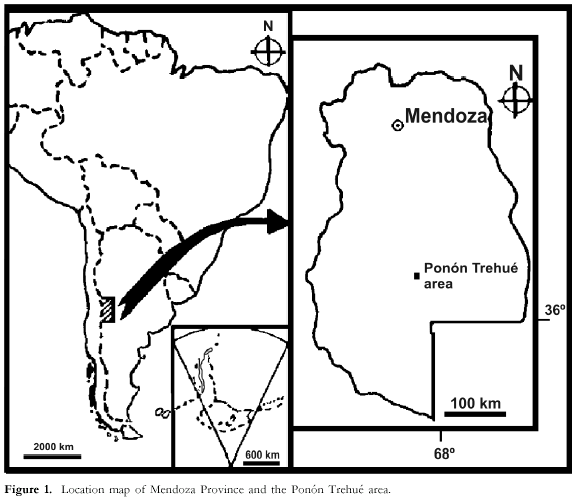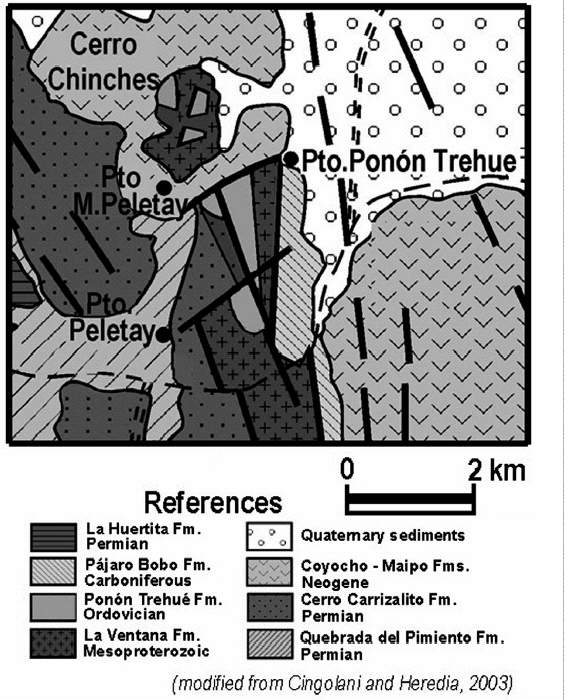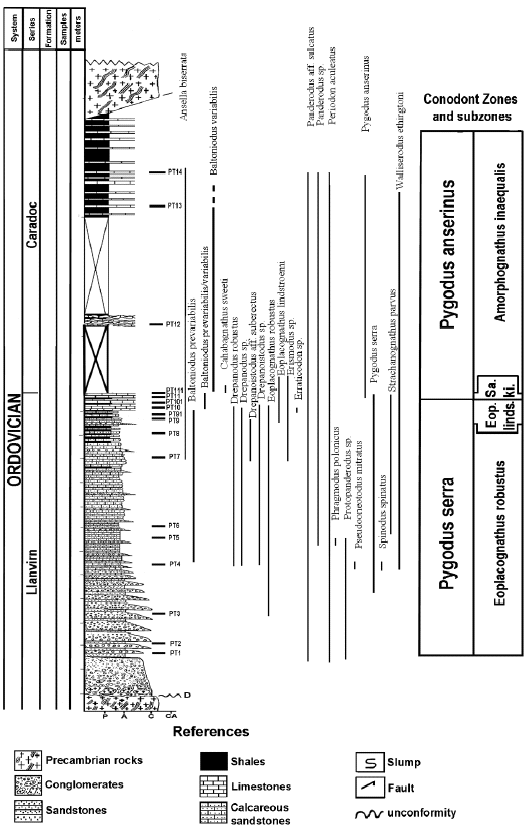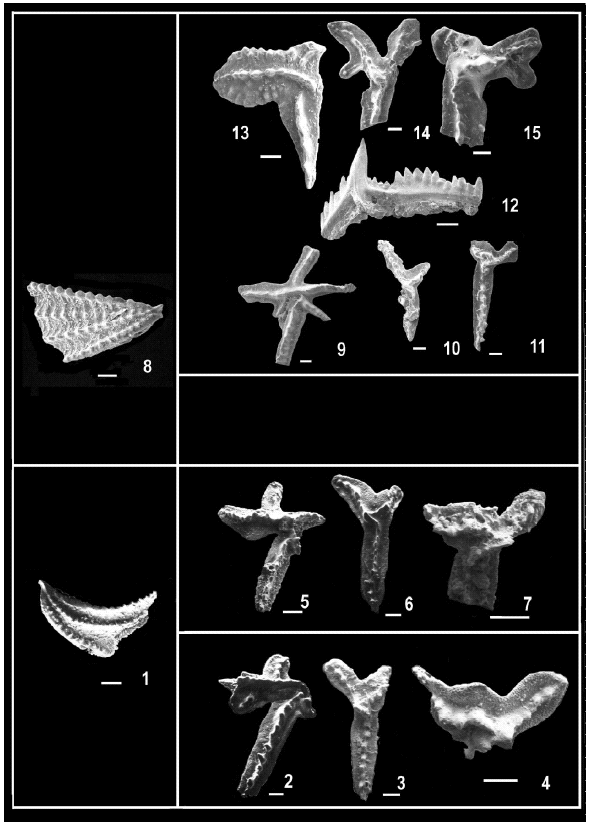
Upper
Llanvirn – Lower Caradoc Conodont Biostratigraphy, Southern Mendoza, Argentina
Susana
HEREDIA1
1 CONICET - Museo de Geología y Paleontología, Universidad Nacional del Comahue. Buenos Aires 1400, (8300) Neuquén, Argentina. E-mail: sheredia@uncoma.edu.ar
Abstract:
UPPER LLANVIRN-
LOWER CARADOC
CONODONT BIOSTRATIGRAPHY, SOUTHERN
MENDOZA,
ARGENTINA. The Ponón Trehué
Formation (Mendoza Province, Argentina) is composed by a coarse clastic sequence
transitionally followed by a fine dark carbonate sequence; the lower one
includes Upper Cambrian to Arenig olistoliths and blocks, and Lower to Middle
Llanvirn fragments of different sizes. A synthesis of the biostratigraphy of
Upper Llanvirn-Lower Caradoc conodonts from the Ponón Trehué Formation is
presented. The following conodont biozones can be recognized: Pygodus serra Zone
with the Eoplacognathus robustus Subzone and the Eoplacognathus
lindstroemi Subzone, and Pygodus anserinus Zone with the Sagittodontina
kielcensis subzone and the Amorphognathus inaequalis subzone.
Allochthonous conodonts recovered from clasts and from olistoliths are
mentioned.
Resumen:
BIOESTRATIGRAFÍA
DE CONODONTES DEL LLANVIRNIANO
SUPERIOR-CARADOCIANO
INFERIOR DEL SUR DE MENDOZA,
ARGENTINA.
La Formación Ponón Trehué (provincia de Mendoza, Argentina) está compuesta
por una secuencia clástica gruesa seguida, transicionalmente, por calizas
oscuras de grano fino; la unidad inferior incluye olistolitos, bloques y
fragmentos de diversos tamaños cuyas edades van desde el Cámbrico superior-
Tremadociano, Arenigiano, al Llanvirniano inferior y medio. Se presenta una síntesis
de la bioestratigrafía de esta formación basada en conodontes. Se han
reconocido las siguientes biozonas de conodontes: la Zona de Pygodus serra con
la Subzona de Eoplacognathus robustus Subzone y la Subzona de Eoplacognathus
lindstroemi, y la Zona de Pygodus anserinus con la Subzona de
Sagittodontina kielcensis y la Subzona de Amorphognathus inaequalis.
Dentro de este contexto se mencionan los conodontes alóctonos recuperados de
clastos y olistolitos.
Key
words: Ponón Trehué. Mendoza. Conodonts. Ordovician. Biostratigraphy.
Palabras
clave: Ponón
Trehué. Mendoza. Conodontes. Ordovícico. Bioestratigrafía.
Introduction
Outcrops
of the Precordillera terrane, extend from 29º S to 33º S latitude, and
correlative rocks appear near San Rafael City (35º S / 68º 20 ‘ W) in the
south of Mendoza Province, Western Argentina (Figure 1)(“Cuyania” of Ramos,
1995; Keller et al., 1996). These lower Paleozoic exposures occur in the
Sierra Pintada range, which represent the San Rafael Block (Criado Roqué and Ibáñez,
1979).
In
the San Rafael Block the lowest sedimentary unit is represented by the Ponón
Trehué Formation, whose Llanvirn-Caradoc deposits suggest shallow clastic to
deep carbonate facies. Astini (1999) suggests that these deposits represent an
extensional episode postdating the collision of the Precordillera terrane.
The
Ponón Trehué Formation overlies the Precambrian basement (Cerro La Ventana
Formation), which is composed of Grenvillian (Bordonaro et al., 1996)
rocks: gneisses, granitoids and siliciclastic metasediments. These rocks are
alternatively overlain by Ordovician (Ponón Trehué Formation) and
Carboniferous strata (Pájaro Bobo Formation), which present a
northwest-southeast alignment.
The
relationship between the continental reddish sedimentary rocks of Carboniferous
age and the igneous-metamorphic Grenvillian complex is tectonic, while the
contact between the latter ones and the Ordovician clastic sediments is an
erosive unconformity (Criado Roqué and Ibáñez, 1979; Heredia, 1996) (Figure
2).
Recently,
Bordonaro et al. (1996) proposed new stratigraphical formal units called
Ponón Trehué Formation (Tremadocian-Arenig) and Lindero Formation (Upper
Llanvirn-Lower Caradoc). Heredia (2001) and Astini (2002) suggested that the
limestones of the Ponón Trehué Formation (Bordonaro et al., 1996) were
blocks and fragmentary carbonate bodies discontinuously exposed floating in
arkose conglomerate. In fact, different sections of these Ordovician outcrops
have a few meters in thickness, and a problem of scale has been verified in
mapping the succession. Only one formal stratigraphic unit is herein proposed:
the Ponón Trehué Formation (Heredia, 1996). This formation involves two
different deposits: the lower one comprises coarse siliciclastic deposits
(including olistoliths) and the upper one consists of fine, dark carbonate-fine
clastic deposits. The biostratigraphy of these Ordovician outcrops has been
based on conodont assemblages (Heredia, 1982; Bordonaro et al. 1996;
Heredia, 1996; Leslie and Lehnert, 1999; Lehnert et al., 1999; Heredia,
2001) The purpose of this study is to summarize the stratigraphical distribution
of late Llanvirnlower Caradoc conodonts recovered from La Tortuga section of the
Ponón Trehué region. Moreover, a brief comment on allochthonous conodonts from
the coarse deposits and carbonate bodies (“phantom formation”) is included.
Ponón
Trehué Formation at La Tortuga section
This
is a normally graded siliciclastic-carbonate succession, 25 m in thickness
(Figure 3). The basement of the La Tortuga section is composed of metamorphic
rocks (Criado Roqué and Ibáñez, 1979), which are Grenvillian in age. An
erosive surface separates it from the Ordovician sedimentary rocks. A normally
graded, very thick conglomerate that contains pebbles and blocks derived from
the underlying rocks occurs at the base of the unit. It passes transitionally
into very thick sandstones with carbonate cement that show thick parallel
laminations. They are also normally graded with thick grains of quartz
chaotically interbedded among fine silts. These dark gray to black
siliciclasticcarbonate beds exhibit remains of crinoids, trilobites and
brachiopods on the bedding plane surface.
Progressively
to the top, the beds are thinner (1 to 2 cm in thickness) and
laminate-normally-graded carbonate sandstones are recognized. Transitionally,
thin dark limestone beds occur, and grade into slumped limestones and black
shales beds, with floating isolated rounded clasts of quartz. The top of this
succession is truncated by faulting.
The
Ponón Trehué Formation is characterized by an increasing amount of carbonate
material to the top. The sequence represents a transition from a predominantly
coarse clastic shallow regime (Astini, 2002) to a predominantly clinoform
deep-water carbonate regime (Heredia and Beresi, 2000; Beresi and Heredia, 2000;
Heredia, 2001; Astini, 2002).
Biostratigraphy
Considerable
efforts have been made to establish global series and stage subdivision of the
Ordovician System to replace the local classifications (Webby, 1998). The term
“Llandeilo”, which is used in the present paper, was retained as a stage for
the upper part of the British Llanvirn Series.
This comprises the upper part of the Pygodus serra Zone, Eoplacoganthus robustus and E. lindstroemi subzones and the lower part of the Pygodus anserinus Zone (Sagittodontina kielcensis Subzone) (Fortey et al., 2000).

Conodont
zones and subzones
The
conodont collections of the Ponón Trehué Formation are housed at the Museum of
Paleontology of the National University of Córdoba, Argentina (CORD-MP
2220-2358) (S. Heredia collection), and at Ianigla, CRICyT, Mendoza, Argentina
(IANIGLA PI 710-762 and 763-814) (O. Lehnert collection). The preservation of
conodonts is good, and they frequently occur complete, except for those of large
size or with long processes. Reworked conodonts are usually broken (Heredia,
2001) and partly recrystallized (Lehnert et al., 1999). The conodont
elements exhibit a high Color Alteration Index (CAI of Epstein et al.,
1977) 5 to 6, indicating a paleotemperature over 300º C. Present Upper Llanvirn
- Lower Caradoc conodont collection appears to have a close affinity with those
ones studied by Dzik (1994) and Bergström et al. (1987).
Numerous
and well preserved conodonts occur in clastic-carbonate rocks in the Ponón
Trehué Formation, being these levels assigned to the Llanvirn British Series
(Llandeilo Stage) by index conodont species following the biostratigraphic
scheme of the Argentine Precordillera proposed by Albanesi et al. (1998).
Several hundreds of specimens of platform conodonts have been recovered from
this section, and conodont zones and subzones can be recognized. The assemblage
is dominated by typically North Atlantic species (showing rather high
contributions of Eoplacognathus and Pygodus) with particular
influence of taxa from the Midcontinent Realm. The conodont distribution in the
Ponón Trehué Formation allows us to recognize two biozones: the Pygodus
serra Zone and Pygodus anserinus Zone (Figure 3 and Plate 1).
Pygodus
serra Zone (Plate 1)
Based
on the recovery of the eponymous species of the Pygodus serra Zone from
sample PT 3 to PT 10, and other index species, two subzones are recognized: Eoplacognathus
robustus and E. lindstroemi.
Eoplacognathus
robustus Subzone (Plate 1)
The
La Tortuga Section starts with the Pygodus serra Zone/Eoplacognathus
robustus Subzone. This interval shows E. robustus in diverse
evolutionary stages. The stratigraphic interval that ranges from sample PT3 to
PT8 (Figure 3) contains: Pygodus serra (Hadding), Eoplacognathus
robustus Bergström, Baltoniodus prevariabilis (Fåhræus), Periodon
aculeatus Hadding, Ansella sinuosa Stouge, Ansella biserrata Lehnert
et Bergström, Pseudooneotodus mitratus (Moskalenko), Spinodus
spinatus (Hadding), Phragmodus polonicus Dzik, Strachanognathus
parvus Rhodes, D. reclinatus (Lindström), Drepanoistodus aff.
suberectus, Erismodus sp, Erraticodon sp., Panderodus aff.
sulcatus, Protopanderodus rectus (Lindström) and Costiconus
ethingtoni (Fåhræus).
Eoplacognathus
lindstroemi Subzone (Plate 1)
The
lower limit is determined by the first appearance of E. lindstroemi (Hamar),
where the amorphognatiform (sp) element of E. robustus changes to an
earlier form of E. lindstroemi. This is pointed out by the change of the
posterior-lateral processes form and the straight inner and outer processes
carina, the Y and T-shaped elements shows little differences with those of the E.
robustus. The conodont association (PT 9 to PT 10) includes P. serra,
E. robustus, E. lindstroemi, Baltoniodus
prevariabilis-variabilis transition (sensu Dzik, 1994), A. sinuosa,
A. biserrata, C. ethingtoni, S. parvus, P. aculeatus, Erraticodon
sp, D. reclinatus, Phragmodus? sp. and Panderodus sp.
Subzones defined by Lehnert et al. (1999) such E. reclinatus and E.
elongatus Bergström (early form) lack of appropriate place of sampling (no
GPS coordinates). It should be noted that the occurrence of index conodonts such
as P. serra, E. robustus and E. lindstroemi have been
already mentioned for the Los Azules Formation (Hünicken and Ortega, 1987), the
Yerba Loca Formation (Albanesi et al., 1995 b) and the allochthonous
clasts of the La Cantera Formation (Albanesi et al., 1995 a),
respectively.
Pygodus
anserinus Zone (Plate 1)
Two
subzones can be recognized on the base of conodont assemblages.
Sagittodontina
kielcensis Subzone
The
first occurrence of P. anserinus Lamont et Lindström marks the
beginning of the Pygodus anserinus Zone (sample PT11, Figure 3) where
forms of P. serra are still present. This association suggests the lowest
part of the Pygodus anserinus Zone, i.e., the Sagittodontina
kielcensis Subzone of the North Atlantic Scheme (Bergström, 1983). The Pygodus
anserinus Zone includes: P. anserinus, B. prevariabilis-variabilis
transition, P. aculeatus, S. parvus and P. serra.
Amorphognathus
inaequalis Subzone (Plate 1)
When Pygodus anserinus occurs together with E. lindstroemi (late form), Cahabagnathus sweeti (Bergström) and Baltoniodus variabilis (Bergström) it is possible to refer to the A. inaequalis Subzone of the North Atlantic Scheme (Bergström, 1983, Lehnert et al., 1999) (Figure 3). Amorphognatiform (sp) elements of E. lindstroemi usually exhibit variable forms, but specimens from sample PT111 frequently show the postero-lateral process bent strongly toward outer side (being the inner and outer processes arranged no linearly). Some Eoplacognathus oz elements (both T-shaped and Yshaped forms) developed lobes in the right side of the internal process. This morphology was not

recorded
until present and it could represent a new species of Eoplacognathus.
Nevertheless, sp forms can not be clearly distinguished from this assemblage.
Cahabagnathus
sweeti was already recorded for this locality (Lehnert et
al., 1999). In my own collection a complete apparatus does appear, which is
not a common form but a Midcontinent pelagic species (Bergström, 1983) (Figure
3 and Plate 1). This level is related to the maximum transgression recorded in
the basin following Astini’s (2002) criteria.
Figure 2. Geological map of the Ponón Trehué area.

Figure 3
. La Tortuga section with ranges of selected conodont species and biostratigraphic scheme for the Ponón Trehué Formation.Allochthonous
conodonts
In
the northern sector, at the Cerro Ai Sol section, Bordonaro et al. (1996)
described a shallow to middle carbonate platform deposit. In this section,
Lehnert et al. (1998) identified elements of Striatodontus prolificus (Ji
et Barnes), Colaptoconus quadraplicatus (Branson et Mehl), Eucharodus
parallelus (Branson et Mehl), “Drepanodus” gracilis (Branson
et Mehl), Bergstroemognathus extensus (Graves et Ellison), Drepanodus
arcuatus Pander, Juanognathus jaanussoni Serpagli, O. communis (Ethington
et Clark), Reutterodus andinus Serpagli, Scolopodus rex Lindström,
S.? krummi (Lehnert), Tropodus sweeti (Serpagli), Fahraeusodus
marathonensis (Bradshaw), Oepikodus evae (Lindström), Periodon
flabellum (Lindström), Protopanderodus gradatus Serpagli, D.
forceps (Lindström), Erraticodon? balticus Dzik, Oistodus aff.
lanceolatus Pander, Pteracontiodus cryptodens Mound, Drepanodus
basiovalis (Sergeeva), Oistodus? tablepointensis Stouge, Spinodus sp.
These elements can define the following assemblages zones (sensu Lehnert et
al., 1998): P. striatus/C. quadraplicatus Zone, P. proteus/A.? deltatus
Zone, O. evae Zone,
O. intermedius Zone, H. altifrons/A. jemtlandica Zone.
In
the southern sector, at La Tortuga section, the redeposited conodont elements
are more abundant in the lower levels (PT 4 to PT 5) and they are identified as Eoplacognathus
foliaceus (Fåhræus), Eoplacognathus pseudoplanus (Viira), Eoplacognathus
suecicus Bergström, Eoplacognathus reclinatus (Fåhræus), Lenodus?
sp, Dapsilodus sp., Microzarkodina sp., Histiodella? sp.,
Parapaltodus sp., Parapanderodus sp. and Protopanderodus sp.
The
presence of reworked fauna in the lower part of the La Tortuga section allows us
to fill, in part, the blank biostratigraphic interval between recorded faunas
(Lehnert et al., 1998) in blocks and megablocks northward this section.
Conodonts, whose vertical distributions cover this span of time, are Eoplacognathus
pseudoplanus, E. suecicus, E. foliaceus and E. reclinatus.
The latter species has also been recorded from autochthonous deposits (Lehnert et
al., 1999). These redeposited conodonts can be used to prove the former
presence of strata that are now absent in the area (“phantom formations”)
(study in progress).
Acknowledgements.
I thank to Consejo
Nacional de Investigaciones Científicas y Técnicas de Argentina (CONICET) for
support this research (PEI: 0308/97). I also thank to Alejandra Ortiz
for her assistance in the laboratory.
References
Albanesi,
G.L, Benedetto, J.L, and Gagnier, P.Y. 1995. Sacabambaspis janvieri (Vertebrata)
y conodontes del Llandeillano temprano en la Formación La Cantera,
Precordillera de San Juan, Argentina. Boletín de la Academia Nacional de
Ciencias, 60(3-4):519-543. Córdoba.
Albanesi,
G.L., Hünicken, M.A. and Barnes, C.R. 1998. Bioestratigrafía de conodontes de
las secuencias ordovícicas del Cerro Potrerillo, Precordillera Central de San
Juan, R. Argentina. Actas Academia Nacional de Ciencias, XII: 7-72. Córdoba.
Albanesi,
G.L., Hünicken, M.A. and Ortega, G. 1995. Conodontes y graptolitos de la
Formación Yerba Loca (Arenigiano-Llandeiliano) en las Quebradas de Ancaucha y
El Divisadero, Precordillera de San Juan, Argentina. Boletín Academia
Nacional de Ciencias, 60 (3-4):365-400. Córdoba.
Astini,
R. 1999. Sedimentological
constrains on the Middle-Upper Ordovician extension in the exotic-to-Gondwana
Precordillera Terrane. Acta
Universitatis Carolinae-Geologica 1999, 43 (1/2):119-122. Praha.
Astini,
R. 2002. Los conglomerados basales del Ordovícico de Ponón Trehué (Mendoza) y
su significado en la historia sedimentaria del terreno exótico de
Precordillera. Revista de la Asociación Geológica Argentina 57(1):19-
34. Buenos
Aires
Beresi,
M. and Heredia, S. 2000. Sponge spicule assemblages from the Middle Ordovician
of Ponón Trehué, Southern Mendoza, Argentina. Revista Española de Paleontología 15(1):37-48.
Bergström,
S. 1983. Biostratigraphy, evolutionary relationships, and biostratigraphic
significance of Ordovician platform conodonts. Fossils and Strata 15:35
– 58. Oslo. ECOS III Third European Conodont Symposium, Lund, 1982.
Bergström,
S.M., Rhodes, F.H.T. and Lindström, M. 1987. Conodont biostratigraphy of the
Llanvirn-Llandeilo and Llandeilo-Caradoc Series boundaries in the Ordovician
System of Wales and the Welsh Borderland In: Austin, R. L. (Ed.). Conodonts:
Investigative Techniques and Applications. Ellis Horwood Limited, Chichester,
18: 294 – 315.
Bordonaro,
O., Keller, M. and Lehnert, O. 1996. El Ordovícico de Ponón Trehué en la Provincia de
Mendoza (Argentina): Redefiniciones estratigráficas. XIII Congreso Geológico
Argentino y III Congreso de Exploración de Hidrocarburos, Actas I: 541 -
550.
Cingolani,
C. y Heredia S. 2001(En prensa). Field guide on the Ordovician of the Sierra Pintada or
San Rafael Block, Mendoza. International Symposium on the Ordovician System, San
Juan, 2003, Argentina. Serie Miscelánea, Instituto Superior de Correlación Geológica
(INSUGEO) 7.
Criado
Roqué, P. e Ibáñez, G. 1979. Provincia geológica Sanrafaelino-pampeana. In
Academia Nacional de Ciencias. Segundo Simposio de Geología Regional
Argentina 1:837-869.
Epstein,
A.G., Epstein, J.B. and Harris, L.D. 1977. Conodont Color Alteration – an
Index to Organic Metamorphism. U.S. Geological Survey Professional Paper,
995:1 – 27.
Fortey,
R.A., Harper, D.A.T., Ingham, J.K., Owen, A.W., Parkes, M.A., Rushton, A.W.A.
and Woodcock, N. 2000. A revised correlation of Ordovician rocks in the British
Isles. The Geological Society, Special Report nº 24; 83 pp.
Heredia,
S. 1982. Pygodus anserinus Lamont et Lindström (Conodonto) en el
Llandeillano de la Formación Ponón Trehué. Ameghiniana 19 (3-4):
101-104.
Heredia,
S. 1996. El Ordovícico del Arroyo Ponón Trehué, sur de la provincia de
Mendoza. XIII Congreso Geológico Argentino y III Congreso de Exploración de
Hidrocarburos. Actas
I: 601-605.
Heredia,
S. 2001. Late Llanvirn
conodonts from Ponón Treuhué Formation, Mendoza, Argentina. GAIA (Revista
de Geociencias) 16:101-117.
Heredia,
S. and Beresi, M. 2000. Conodont biostratigraphy and paleoenvironment of the
Late Llanvirn -Lower Caradoc (Ordovician), south of the province of Mendoza,
Argentina: 17th Geoscientific Latinamerica Colloquium. Institut für
Geologie und Paläontologie. Universität Stuttgart. Profil, Band 18, p.
48
Hünicken,
M.A. and Ortega, G. 1987. Lower Llanvirn-Lower Caradoc (Ordovician) conodonts
and graptolites from the Argentina Central Precordillera. In: Austin, R. L.
(Ed.). Conodonts: Investigative Techniques and Applications. Ellis
Horwood Limited, Chichester, 7: 136 – 145.
Keller,
M., Lehnert, O. and Bordonaro, O. 1996. The Ordovician of San Rafael: Its
significance for the history of the Precordillera. The Geological Society of
America South - Central Section, Abstract with Programs. University of
Texas, Austin. Volume 28, nº 1, Nº 38748.
Lehnert,
O., Bergström, S., Keller, M. and Bordonaro, O. 1999. Middle Ordovician
(Darriwillian – Caradocian) conodonts from the San Rafael region, west-central
Argentina: Biostratigraphic, paleoecologic and paleogeographic implications. Boll.
della Societá Paleontologica Italiana 37(2-3):199-214.
Lehnert,
O., Keller, M. and Bordonaro, O. 1998. Early Ordovician conodonts from the
southern Cuyania Terrane (Mendoza Province, Argentina). In: H. Szaniawski (ed.)
Proceedings of the Sixth European Conodonts Symposium, (ECOS VI). Palaeontologia
Polonica 58, 47
– 65.
Leslie,
S. and Lehnert, O. 1999. New insight into the phylogeny and paleogeography of Cahabagnathus
(Conodonta). Acta
Universitatis Carolinae – Geologica 1999, 43: 443 – 446.
Ramos,
V.A. 1995. Sudamérica: un mosaico de continentes y océanos. Ciencia Hoy,
6(32): 24-29.
Webby,
B.D. 1998. Steps
toward a global standard for Ordovician stratigraphy. Newsletters in
Stratigraphy 36:1-33.
Recibido:
15 de Agosto de
2002
Aceptado:
15 de Octubre de
2002
Index
conodonts from La Tortuga section (Llandeilo), Ponón Trehué Formation (Sierra
Pintada, Mendoza).
Scanning
electron microscope photomicrographs, scale bar 0,1 mm. 1, Pygodus
serra (Hadding) (P. serra Zone).
CORD
MP 2236 (1) PT8. 2 - 4, Eoplacognathus robustus Bergström (E.
robustus Subzone). Pa element CORD MP 2220(1), PT 3. Dextral Pb element CORD
MP 2223 (1), PT 10. Sinistral Pb element CORD MP 2222(2), PT8. 5 - 7, Eoplacognathus
lindstroemi (Hamar) early form (E. lindstroemi Subzone). Pa element
CORD MP 2269(1), PT 9.
Dextral
Pb element CORD MP 2223(3), PT9. Sinistral Pb element CORD MP 2224 (3), PT 10. 8,
Pygodus anserinus Lamont et Lindström (P. anserinus Zone).
CORD MP 2359 (4), PT 111. 9 – 11, Eoplacognathus lindstroemi (Hamar)
later form. Pa element CORD MP 2355 (5), PT 111. Dextral Pb element CORD MP 2361
(36), PT 111. Sinistral Pb element CORD MP 2362 (29), PT 111. 12,
Baltoniodus variabilis Bergström. Pa element CORD MP 2356 (43), PT 111.
13, Cahabagnathus sweeti (Bergström). Pastiniplanate element CORD MP 2363 (3), PT 111.1 4 - 15, Eoplacognathus lindstroemi? Dextral Pb element CORD MP 2358 (2), PT 111. Sinistral Pb element CORD MP 2357 (3), PT 111.
